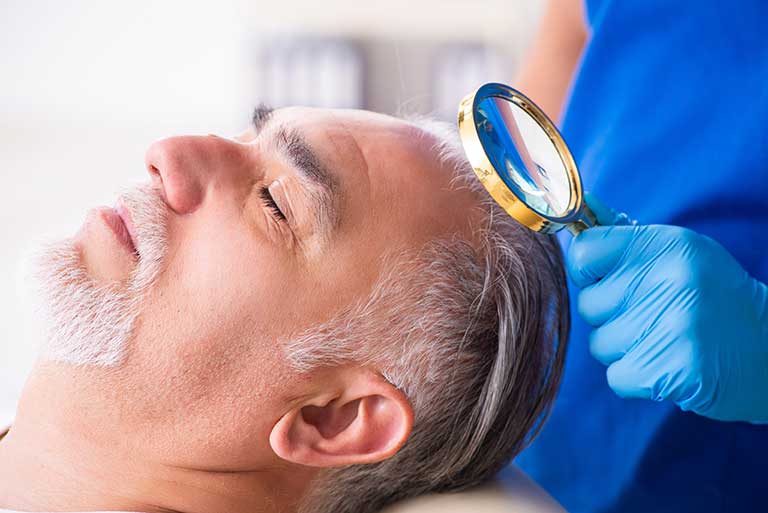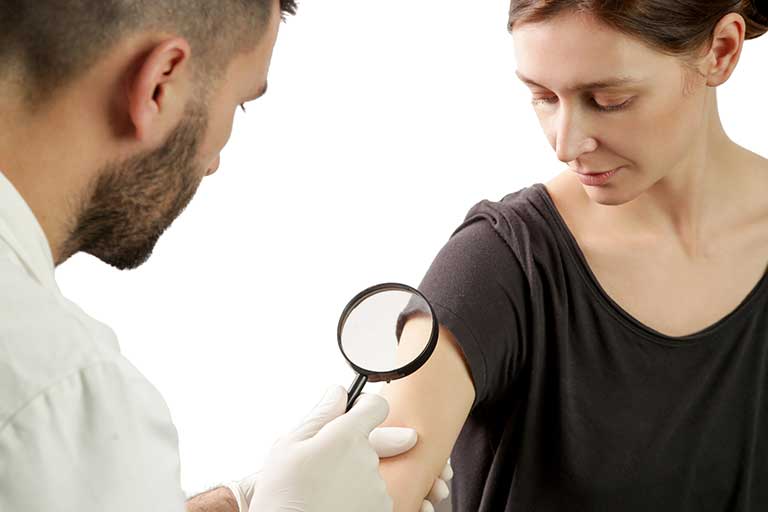All about Actinic keratosis
Actinic keratosis is an area of the skin damaged by ultraviolet radiation that appears in zones exposed to the sun for years. Its appearance is variable.

How does actinic keratosis affect the skin?
Chronic exposure to ultraviolet (UV) radiation from the sun and other sources causes excessive multiplication of keratinocytes, the main cells of the epidermis (the outermost layer of the skin). These keratinocytes also undergo alterations and become atypical, that is different from normal ones. The result is a localized skin lesion that is seen as a thick, rough and scaly patch, also known as actinic keratosis or solar keratosis.
Actinic keratoses are, in short, areas of sun-damaged skin. Most frequently, not only is the area where the lesion appears damaged, but the surrounding region is also damaged as well, exhibiting a yellowish color, with spots or even small broken blood vessels. Other times, this area of surrounding skin looks normal, but when examined under a microscope or by molecular techniques, abnormalities are identified. This area is called field of cancerization.
How to spot actinic keratoses?
To recognize actinic keratoses, examine your skin regularly (for example, every two months), paying special attention to the areas most exposed to the sun―such as the face, lips, ears, bald scalp, forearms, dorsa of the hands and lower legs, where the lesions are usually found.
Visit your dermatologist any time you see something new, changing or unusual on your skin, make an appointment to get checked right away. An early diagnosis and an adequate treatment can increase the chances for a successful recovery.

What do actinic keratoses look like?
At first actinic keratoses can be hard to see with the naked eye, but they can be easily felt as small areas of rough, dry or flaky skin.
As they progress, actinic keratoses usually appear as plaques or scabs between 1 and 3 millimeters in diameter but can grow to several centimeters in size. Actinic keratosis lesions can take different forms and colors, even in the same person. They can also present as single individual lesions or clustered in areas exposed to sunlight. As we have said, the surrounding skin may also have a yellowish appearance or have spots or small broken blood vessels.
- patches of scaly spots similar to a rash or acne;
- flat and flaky area that resembles an age spot;
- skin horn shape: it is usually hard and has a conical appearance.
In the lips, actinic keratosis can also manifest as:
- dry, scaly patches on the lips that do not heal;
- presence of white, scaly plaques;
- loss of color.
What color is an actinic keratosis?
Actinic keratosis lesions come in many colors: yellowish, gray, pink, red, brown, white or can also be the same color as healthy skin.
What shape is an actinic keratosis?
Actinic keratoses can vary in shape:
- rough skin area to the touch, but imperceptible to the naked eye (in initial stages);
- reddish, rough and scaly area, with grain appearance;
- raised and rough red, pink, gray or skin-colored plaque;

Does an actinic keratosis hurt?
Although rare, actinic keratosis lesions can feel tender when touched or cause itching, burning, stick to your clothing, or even bleed. It is important that you talk to your doctor if you notice any of these symptoms, as squamous cell carcinoma may present with the same symptoms. Actinic keratosis lesions can progress into this type of cancer and can be indistinguishable based on appearance alone. Detecting an actinic keratosis early gives you the opportunity to treat it and prevent skin cancer before it starts. When diagnosed promptly, almost all actinic keratoses can be successfully removed.
References
- De Berker, D., McGregor, J.M., Mohd Mustapa, M.F., Exton, L.S., Hughes, B.R. British Association of Dermatologists’ guidelines for the care of patients with actinic keratosis 2017. Br J Dermatol [Internet]. 2017 Jan 18 [cited 2020 Feb 19]; 176(1):20-43. Available at: https://onlinelibrary.wiley.com/doi/full/10.1111/bjd.15107
- Werner RN, Stockfleth E, Connolly SM, et al. Evidence- and consensus-based (S3) Guidelines for the Treatment of Actinic Keratosis - International League of Dermatological Societies in cooperation with the European Dermatology Forum - Short version [Internet]. J Eur Acad Dermatol Venereol. 2015;29(11):2069-79. Available at: http://doi.wiley.com/10.1111/jdv.13180
- Moy, R.L. Clinical presentation of actinic keratoses and squamous cell carcinoma. J Am Acad Dermatol [Internet]. 2000 Jan [cited 2020 feb 20];42(1 Suppl. 1):S8–10. Available at: https://www.jaad.org/article/S0190-9622(00)27494-X/fulltext. doi.10.1067/mjd.2000.103343.
- British Association of Dermatologists (BAD). Actinic Keratoses - Also Known as Solar Keratoses [Internet]. 2007 May [revised 2019 Nov; cited 2020 Feb 19]; 5 p. Available at: http://www.bad.org.uk/shared/get-file.ashx?id=66&itemtype=document
- Skin Cancer Foundation. Actinic Keratosis Warning Signs [Internet]. 2019 May [cited 2020 Feb 19]; approx. 5 screens. Available at: https://www.skincancer.org/skin-cancer-information/actinic-keratosis/actinic-keratosis-warning-signs-and-images/
- American Academy of Dermatology (AAD). Actinic keratosis: signs and symptoms [Internet]. 2020 [cited 2020 Feb 19]; approx. 5 screens. Available at: https://www.aad.org/public/diseases/skin-cancer/actinic-keratosis-symptoms
Frequently asked questions about actinic keratosis
Actinic keratosis is not hereditary, although some of the factors that favor its appearance, such as fair skin or freckles, are so. Actinic keratosis is not contagious.
Actinic keratosis is an uncontrolled proliferation of keratinocytes: the most abundant cells of the epidermis (the outermost layer of the skin), that become abnormal4. Some actinic keratoses can turn into a type of skin cancer called epidermoid carcinoma or invasive squamous cell carcinoma1,4. Although rare, this type of cancer can spread to other tissues, and it is therefore recommended to treat all actinic keratoses.
Furthermore, a person with actinic keratosis is at higher risk of developing any type of skin cancer compared to another person of the same age who does not. People who have a higher number of actinic keratoses also run a higher risk of skin cancer.
Some actinic keratoses resolve spontaneously, especially if sunscreen or protection is used, although most remain as they are. Others may progress into invasive squamous cell carcinoma. Unfortunately, it is impossible to know in advance which ones will in fact progress into invasive squamous cell carcinoma. The clinical course of the condition cannot be predicted.
Actinic keratosis lesions can heal and disappear spontaneously or through treatment. However, it is very common for old lesions to recur or for new ones to come out. The presence of a single actinic keratosis is already a sign that chronic damage from solar radiation has occurred, and hence there is a risk that other lesions could appear. Therefore, if you have actinic keratosis, your doctor will monitor you regularly, and will recommend that you seek consultation if you notice new lesions or any changes in the ones you already have.
Protecting yourself from the sun is essential to prevent the appearance of actinic keratosis and slow down progression. Following the following measures strictly is key to keeping actinic keratoses under control:
Use sunscreen and clothing that covers your body.
- Avoid peak sun hours.
- Avoid artificial sunlight (sun beds/tanning salons).
- Check your skin at home and schedule an appointment with the dermatologist on a regular basis.
